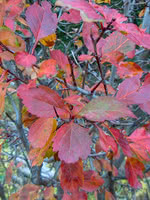Mon-Fri 9am - 5pm Mountain time
Common Purple Lilac vs Black Hawthorn
Syringa vulgaris
Crataegus douglasii
NOT AVAILABLE THIS SEASON - MIGHT RETURN
Common Purple Lilac is a popular lilac. This large shrub provides excellent privacy or wind protection in an attractive package.
Lilac flowers are pleasantly fragrant and add a beautiful lavender colour to your property. Common Purple Lilac is cold hardy, easy to grow, and can tolerate most soil types.
Some people alternate villosa and common purple lilacs to create the impression that the hedge is in flower for almost a full month with the common purple flowering about 2 weeks sooner than the Villosa Lilac.
Black Hawthorn is a versatile plant that is native to wetlands and other areas with moist soils, but can also tolerate dry soils. This plant can be grown as a short shrub, or a tree reaching 30 feet tall.
Black Hawthorn is valued for erosion control and attracting pollinators. It also makes an attractive flowering ornamental that can be planted as a specimen or pruned as a hedge. It is commonly used in shelterbelts.
Common Purple Lilac Quick Facts
Black Hawthorn Quick Facts
In row spacing: 0.9 m (3 ft)

